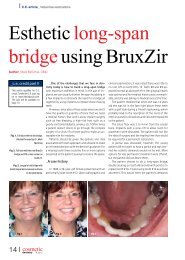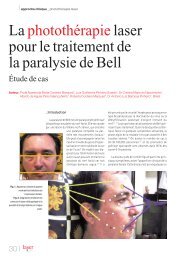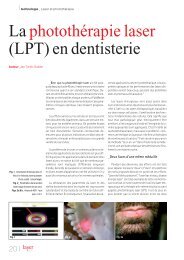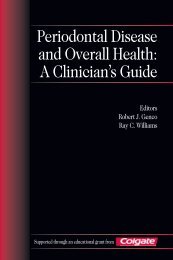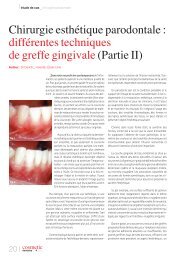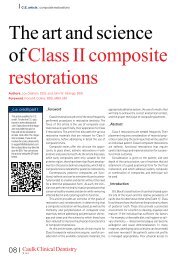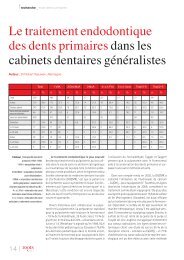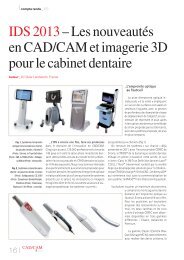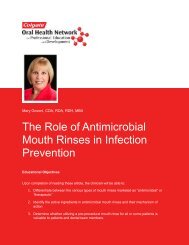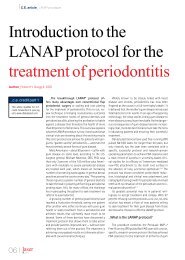CHAPTER 3 Infection <strong>and</strong> Inflammation 41disease. 5th Edition. Garl<strong>and</strong> Publishing, NewYork; 2001:44.27. Loos BG. Systemic markers of inflammation inperiodontitis. J Periodontol 2005;76:2106–2115.28. Christan C, Dietrich T, Hägewald S, Kage A, BernimoulinJP. White blood cell count in generalizedaggressive periodontitis after non-surgical therapy.J Clin Periodontol 2002;29:201–206.29. Mengel R, Bacher M, Flores-De-Jacoby L. Interactionsbetween stress, interleukin-1beta, interleukin-6<strong>and</strong> cortisol in periodontally diseasedpatients. J Clin Periodontol 2002;29:1012–1022.30. Meyle J. Neutrophil chemotaxis <strong>and</strong> serum concentrationof tumor-necrosis-factor-alpha (TNF-).J <strong>Periodontal</strong> Res 1993;28(Pt 2):491–493.31. Paraskevas S, Huizinga JD, Loos BG. A systematicreview <strong>and</strong> meta-analyses on C-reactive protein inrelation to periodontitis. J Clin Periodontol 2008;35:277–290.32. Kweider M, Lowe GD, Murray GD, Kinane DF,McGowan DA. Dental disease, fibrinogen <strong>and</strong>white cell count; links with myocardial infarction?Scott Med J 1993;38:73–74.33. Scannapieco FA. Position paper of The AmericanAcademy of Periodontology: periodontal disease asa potential risk factor for systemic diseases. J Periodontol 1998;69:841–850.34. Ridker PM, Rifai N, Pfeffer M, Sacks F, Lepage S,Braunwald E. Elevation of tumor necrosis factoralpha<strong>and</strong> increased risk of recurrent coronaryevents after myocardial infarction. Circulation2000;101:2149–2153.35. Ridker PM, Buring JE, Rifai N. Soluble P-selectin<strong>and</strong> the risk of future cardiovascular events. Circulation 2001;103:491–495.36. Ridker PM, Cushman M, Stampfer MJ, Tracy RP,Hennekens CH. Inflammation, aspirin, <strong>and</strong> the riskof cardiovascular disease in apparently healthymen. N Engl J Med 1997;336:973–979.37. Treszl A, Szereday L, Doria A, King GL, Orban T.Elevated C-reactive protein levels do not correspondto autoimmunity in type 1 diabetes. DiabetesCare 2004;27:2769–2770.38. Shoelson SE, Lee J, Goldfine AB. Inflammation<strong>and</strong> insulin resistance. J Clin Invest 2006;116:1793–1801.39. Serhan CN, Jain A, Marleau S, Clish C, Kantarci A,Behbehani B, Colgan SP, Stahl GL, Merched A,Petasis NA, Chan L, Van Dyke TE. Reduced inflammation<strong>and</strong> tissue damage in transgenic rabbitsoverexpressing 15-lipoxygenase <strong>and</strong> endogenousanti-inflammatory lipid mediators. J Immunol2003;171:6856–6865.40. Williams RC, Jeffcoat MK, Howell TH, Reddy MS,Johnson HG, Hall CM, Goldhaber P. Topical flurbiprofentreatment of periodontitis in beagles. J<strong>Periodontal</strong> Res 1988;23:166-169.41. Ariel A, Fredman G, Sun YP, Kantarci A, Van DykeTE, Luster AD, Serhan CN. Apoptotic neutrophils<strong>and</strong> T cells sequester chemokines during immuneresponse resolution through modulation of CCR5expression. Nat Immunol 2006;7:1209–1216.42. Schwab JM, Chiang N, Arita M, Serhan CN. ResolvinE1 <strong>and</strong> protectin D1 activate inflammationresolutionprogrammes. Nature 2007;447:869–874.43. Shen J, Herderick E, Cornhill JF, Zsigmond E, KimHS, Kühn H, Guevara NV, Chan L. Macrophagemediated15-lipoxygenase expression protectsagainst atherosclerosis development. J Clin Invest1996;98:2201–2208.44. Hasturk H, Kantarci A, Ohira T, Arita M, EbrahimiN, Chiang N, Petasis NA, Levy BD, Serhan CN,Van Dyke TE. RvE1 protects from local inflammation<strong>and</strong> osteoclast-mediated bone destruction inperiodontitis. FASEB J 2006;20:401–403.45. Karp CL, Flick LM, Park KW, Softic S, Greer TM,Keledjian R, Yang R, Uddin J, Guggino WB, AtabaniSF, Belkaid Y, Xu Y, Whitsett JA, Accurso FJ,Wills-Karp M, Petasis NA. Defective lipoxinmediatedanti-inflammatory activity in the cysticfibrosis airway. Nat Immunol 2004;5:388–392.46. Hudert CA, Weyl<strong>and</strong>t KH, Lu Y, Wang J, Hong S,Dignass A, Serhan CN, Kang JX. Transgenic micerich in endogenous omega-3 fatty acids are protectedfrom colitis. Proc Natl Acad Sci USA 2006;103:11276–11281.47. Connor KM, SanGiovanni JP, Lofqvist C, AdermanCM, Chen J, Higuchi A, Hong S, Pravda EA,Majchrzak S, Carper D, Hellstrom A, KangJX, Chew EY, Salem N Jr, Serhan CN, SmithLE. Increased dietary intake of omega-3-poly -un saturated fatty acids reduces pathological retinalangiogenesis. Nat Med 2007;13:868–873.48. Levy BD, Bonnans C, Silverman ES, Palmer LJ,Marigowda G, Israel E. Severe Asthma ResearchProgram, National Heart, Lung, <strong>and</strong> Blood Institute.Diminished lipoxin biosynthesis in severe asthma.Am J Respir Crit Care Med 2005;172:824–830.
CHAPTER 4History of theOral-Systemic RelationshipNoel M. Claffey, Ioannis N. Polyzois, Ray C. WilliamsINTRODUCTIONIn the last decade, the possible associationbetween oral <strong>and</strong> systemic health has beenhighlighted in numerous reports. The focus ofattention is mainly periodontitis <strong>and</strong> its impacton certain conditions. Periodontitis is an infec -tious disease associated with a number of pre -dominantly gram-negative bacteria, <strong>and</strong> it is nowrecognized that for the initiation <strong>and</strong> progressionof this disease, a susceptible host is also required.It is also well documented that certain systemicconditions can modify the host’s susceptibility toperiodontitis, but it is only recently that evidencesurfaced about the possi bility of a two-way rela -tionship. Speci fically, perio dontitis has been impli -cated as a potential risk factor for cardio vas culardiseases, respiratory diseases, diabetes mellitus,preterm labor, low birth weight, <strong>and</strong> renal disease.Interest in the relationship of oral health/periodontal disease to general health is not new,but more of a resurgence in the old <strong>and</strong> dis creditedcon cept of focal infection. Focal infec tion theorybe came popular in the begin ning of the twentiethcentury because it explained a number of con -ditions for which there was no sci entific explana -tion at the time. It eventually fell in to disreputebecause of a lack of scientific evidence.This chapter examines the history of thehypothesis that micro-organisms would localizefrom the source focus to the distant, systemicfocus <strong>and</strong> follows, step by step, concepts of theoral-systemic relationship that have evolvedover the years.ANCIENT CIVILIZATIONSAND THE MIDDLE AGESThroughout recorded history, manytheories have been put forward to explainhuman illness. One area of the body that hasbeen repeatedly implicated in the origin ofhuman diseases is the oral cavity. Writings asfar back as from the ancient Egyptians (2100BC) mention tooth pain associated withwomen’s reproductive system diseases. 1 InAssyria, the physician of King Ashurbanipal(669–626 BC) wrote about the troubles ofhis king: “The pains in his head, arms, <strong>and</strong>feet are caused by his teeth <strong>and</strong> must beremoved.” 2 In ancient Greece, Hippocrates(400 BC) recorded two cases in which eradicationof the infections of the mouth appearedto relieve patients of rheumatic-liketroubles of the joints. 3 Aristotle, perhaps thefirst dental anatomist—especially from thest<strong>and</strong>point of comparative anatomy—statedthat “those persons who have the most teethare the longest lived.” 4 In his book, On Hygiene,the Roman physician Galen (166–201AD) emphasized the inter-relationship betweenthe oral cavity <strong>and</strong> other illnesses. 5From the end of the Roman Empireuntil the middle ages, all sciences fell intoabeyance, <strong>and</strong> had it not been for the Arabs(who had access to the learning <strong>and</strong> sciencecontained in Greek manuscripts brought totheir country by Nestorian exiles from By -zantium <strong>and</strong> Greeks who settled in southernItaly), the bulk of science <strong>and</strong> knowledgeaccumulated to that date might have beenlost. 4 The next notable advance in dentistryprobably occurred in Italy in the 1400s whena physician named Giovanni d’Arcoli beganfilling decayed teeth with gold leaf; anadmirably progressive step for that time. Heis further credited with stating that for casesof severe dental pain, early intervention was



